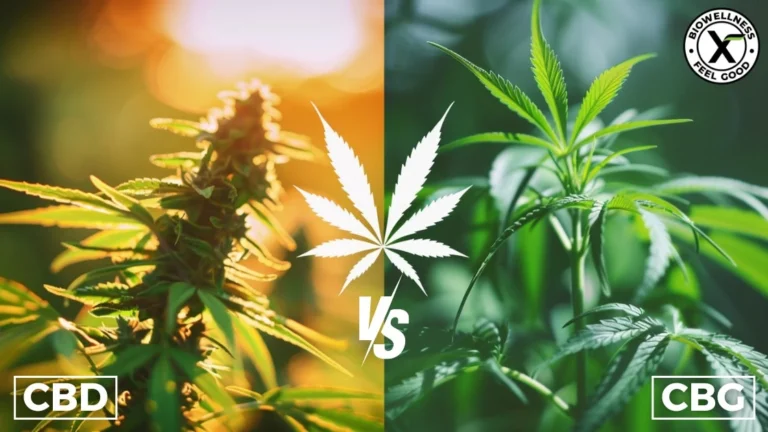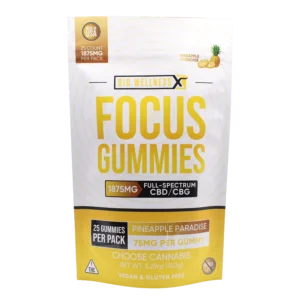By now, most are familiar with the hype of the cannabis sativa plant and the beneficial compounds we are getting from basically every part of this plant.
But sometimes, even a person who knows his fair share of cannabidiol information can get confused with the alphabet soup of all the compounds we are getting from the cannabis plant.
In this article, we are going to discuss the two major cannabinoids that are dominating the markets these days, the differences between them, and the beneficial properties they have to offer.
Let’s get started!
Key Takeaways
- CBG is a relatively new cannabinoid, but it’s called the mother of cannabinoids and has a lot of similarities with CBD.
- CBG and CBD both have multiple health benefits, and more research is being conducted to get the best out of them.
- Choose between CBG and CBD based on your physical and psychological requirements.
- CBG and CBD both have potential side effects which can be minimized with caution.
- Always opt for the best quality CBG and CBD products you can find for better results and greater benefits.
Cannabinoid Cousins: Exploring the Similarities and Differences Between CBD and CBG
It’s quite difficult for us people to sometimes tell two different people apart if they are blood-related, right? Imagine both of them having the same appearance; it would take a whole day for us to recognize who is who!
Well, we are going to discuss the same thing, but this time, it will be related to the family of the hemp plant cannabis sativa.
First, we will talk about the OG of the group, CBD. Why are we calling it the OG? Well, it’s the popular one, comes before its cousin CBG in the market and also it has quite some quality research done on itself unlike its cousin CBG. So what exactly is CBD?
CBD, also known as cannabidiol or CBD oil, emerges as a fascinating cannabinoid sourced from cannabis plants. While THC once claimed the spotlight in cannabinoid research, the past two decades have witnessed a rise in CBD studies.
This surge in interest stems from the growing recognition of CBD’s potent anti-inflammatory properties, captivating researchers and enthusiasts alike.
On the other hand, the minor cannabinoid CBG, aka cannabigerol – the lesser-known cannabinoid found in the cannabis plant is often referred to as the “mother of all cannabinoids” due to its role in producing other cannabinoids like THC and CBD.
In short, we can state that CBD and CBG are two types of compounds found in cannabis. CBD has become really popular lately because it offers many health benefits without making you feel high. CBG is a newer type of supplement that’s not as well-known yet but seems promising for health.
Now, let’s shed some light on the similarities and differences between these two cannabinoids.
Similarities between CBD and CBG
- CBG and CBD hail from the same source: The remarkable Cannabis sativa, also known as the hemp plant.
- Neither CBG nor CBD are known to induce a psychedelic experience – they are considered “non-intoxicating” cannabinoids, meaning they do not cause hallucinations.
- They both have anti-inflammatory properties and a long list of natural benefits.
- Ever since the 2018 Farm Bill was passed, CBG and CBD have been federally legal, opening the doors wide for exploration and innovation.
- According to many users, both CBG and CBD have the ability to reduce stress, leading to a peaceful night’s sleep and an overall sense of calm.
- Whether you prefer your cannabinoids in tinctures, gummies, or capsules, you will find both CBG and CBD available in a variety of forms to enhance your wellness routine.
Differences between CBD and CBG
- CBG doesn’t make you feel high, unlike THC. CBD also doesn’t make you high, but it might help reduce the high feeling from THC.
- CBG and CBD could help with different health issues:
- CBG: It might be helpful for conditions like glaucoma, inflammatory bowel disease, diseases that affect the brain and nerves, and even cancer.
- CBD: People are interested in CBD because it might help with anxiety, discomfort, and swelling. It’s also being studied for how it could help with epilepsy, schizophrenia, and other mental health conditions.
- There’s more CBD in hemp plants than CBG, so CBD is easier to find. But CBG is becoming more popular as people find better ways to get it out of plants.
Unlocking Potential: Exploring the Therapeutic Applications of CBD and CBG
Have you ever wondered if there’s a natural remedy out there capable of treating anxiety and soothing ailments without the side effects of traditional medication? Yes, there certainly is! And you’re gonna find out about these remedies soon.
The answer is cannabinoids. Most certainly CBD and CBG.
Learning about the interaction of CBD and CBG can answer all your questions. But first, it’s important to understand how CBD and CBG can work together with other medications to improve health. Combining the therapeutic effects of these two with other methods allows us to find new ways to stay healthy.
As we have already comprehended, CBD, short for cannabidiol, and CBG, or cannabigerol, are compounds found in cannabis plants. Unlike their well-known cousin THC (tetrahydrocannabinol), which is responsible for the “high” associated with marijuana, CBD and CBG are non-psychoactive. This means they won’t alter your mental state, making them safe and legal options for therapeutic use.
Now, what makes CBD and CBG so special? The answer lies in their interaction with the endocannabinoid system (ECS) in our bodies. The ECS is a complex network of receptors and neurotransmitters that helps regulate essential functions like mood, sleep, appetite, and immune response. When we consume CBD or CBG, they interact with the ECS, potentially restoring balance and promoting overall well-being.
What are the cannabinoids present, and what are the therapeutic applications of CBD and CBG?
Therapeutic benefits of CBD:
CBD, short for cannabidiol, holds tremendous potential for therapeutic use, offering a range of potential health benefits. Here’s a glimpse into some of its notable effects:
- Anti-inflammatory Properties: Research suggests that CBD possesses potent anti-inflammatory properties, making it a potential treatment for various conditions. Studies have shown that CBD can reduce inflammation by inhibiting the release of certain inflammatory compounds.
- Smoking Cessation and Withdrawal Management: CBD shows promise in aiding smoking cessation by alleviating anxiety, a common barrier to quitting. Evidence suggests that it can help smokers overcome addiction by reducing their attention to cigarette cues. Moreover, CBD may mitigate withdrawal symptoms associated with substance addiction.
- Seizure Management: The FDA has approved CBD oil for treating seizures associated with specific types of epilepsy, such as Lennox-Gastaut syndrome and Dravet syndrome. Studies have demonstrated that CBD significantly reduces seizure frequency compared to a placebo, offering hope for individuals with treatment-resistant epilepsy.
- Alzheimer’s Disease: CBD exhibits potential in managing the behavioral and psychological symptoms of Alzheimer’s disease. Research in mice suggests that CBD may alleviate symptoms such as behavioral disorders and memory loss. Clinical trials are underway to explore its effectiveness further in treating dementia-related symptoms.
- Anxiety Disorders: CBD has emerged as a promising option for managing anxiety disorders. Studies indicate that it can significantly reduce anxiety symptoms in both humans and animals. A review of multiple studies concluded that CBD holds potential as a treatment for anxiety disorders, offering a natural alternative to traditional medications.
CBD offers a wide range of benefits and is currently the subject of ongoing research. Its potential for managing inflammation, aches and pains, and neurological conditions makes it a compelling option for holistic wellness. As scientific understanding individual therapeutic properties of CBD grows, its role in healthcare is expected to expand, providing hope and relief to many worldwide.
Therapeutic Benefits of CBG:
CBG, short for cannabigerol, offers a plethora of potential therapeutic benefits, making it a fascinating compound worth exploring. Here’s a concise breakdown of its potential applications:
- Anxiety and Sleep: CBG increases GABA levels, a neurotransmitter that promotes relaxation, leading to decreased anxiety and improved sleep quality.
- Anti-inflammatory Effects and Physical Relief: CBG reduces inflammation and painful symptoms by targeting overactive immune cells, potentially alleviating conditions like rheumatoid arthritis and psoriasis.
- Neuroprotection: By reducing inflammation and oxidative stress, CBG protects nerve cells from damage, offering potential benefits for conditions like Parkinson’s disease, neuropathy, and more.
- Muscle Spasms and GI Disorders: CBG via GABA reduces muscle spasms and addresses conditions like spastic colon, IBS, and urgency bladder incontinence.
- Blood Pressure Regulation: CBG relaxes arterial walls, lowering blood pressure and potentially aiding in the management of hypertension.
- Eye Health: CBG reduces eye pressure in glaucoma and enhances drainage from the eye, offering potential benefits for individuals with this condition.
- Appetite Stimulation: CBG can stimulate appetite, which may be helpful for individuals undergoing chemotherapy.
- Nausea and Vomiting: CBG reduces nausea and vomiting, providing relief for chemotherapy patients.
While CBG shows promise in various therapeutic areas, research is still in its early stages. More studies are needed to fully understand its potential benefits and limitations. Despite this, CBG holds significant potential as a natural remedy for a range of health conditions, offering hope for those seeking alternative treatments.
However, it’s essential to approach CBG with caution, as unsubstantiated claims may potentially lead to misinformation. As research progresses, we can expect to uncover more about the remarkable therapeutic properties of CBG.
Finding Your Cannabinoid Fit: Deciding Between CBD and CBG Based on Your Needs
Now that we’ve explored the subtle differences between CBD and CBG, the ultimate question arises: which one should you choose?
There’s no definitive answer, as both cannabinoids offer unique effects and benefits. Let’s break it down:
First, CBD affects the endocannabinoid system, while CBG targets the receptors directly. Second, CBG is known for boosting energy, while CBD tends to have a more calming effect. Finally, CBG shows promise in fighting physical aches and inflammation, while early studies suggest CBD may be better for managing neurological disorders.
When deciding between CBD and CBG, it’s crucial to understand your specific needs.
CBD primarily interacts with the body’s peripheral nervous system, affecting muscles, limbs, and the immune system. In contrast, CBG binds to both CB1 and CB2 receptors, impacting the central nervous system, including the brain and spinal cord.
Ultimately, the choice depends on your physical and psychological requirements. CBD is often associated with promoting relaxation and aiding recovery, while CBG may support mood balance and mental wellness.
Consider your wellness goals and preferences. Are you seeking support for an active lifestyle, or are you interested in enhancing your mood?
Additionally, the type of extract matters. Full-spectrum CBD and CBG products offer an entourage effect with various forms of cannabinoids working together, while broad-spectrum or isolate options provide a THC-free experience.
From Plant to Product: Understanding the Processing Methods of CBD and CBG
CBD and CBG extraction processes are quite similar, but there’s a lot more CBD to get than CBG.
Hemp plants are typically used to extract these cannabinoids. Initially, a crude extraction is performed using special fluids such as supercritical CO2 or ethanol. Subsequently, additional methods are employed to further purify the extract and potentially isolate a single cannabinoid.
The extraction of CBD and CBG from hemp plants is a meticulous process that impacts the purity of the products. Typically, both CBD and CBG are extracted using a solvent or heat to separate them from the plant material.
The main difference in extraction lies in the timing of hemp plant harvest. CBD is derived from mature plants that naturally contain higher levels of CBD. In contrast, CBG is extracted from younger plants, typically around six weeks into their flowering stage, when they have the highest concentration of CBG before it transforms into other cannabinoids.
Once the extraction process is complete, both CBD and CBG extracts undergo a purification process to remove any unwanted materials, such as plant particles or other impurities. The end result is a potent and pure cannabinoid extract.
This extract can then be utilized in a variety of products, including sublingual drops, topical creams, and even edibles. These products may offer beneficial effects for those who use them.
Research in Progress: Looking into Current Scientific Studies on CBD and CBG
As interest in CBD and CBG continues to grow, so does the scientific inquiry into their potential benefits and mechanisms of action.
Researchers are exploring a wide range of applications, from pain management and epilepsy treatment to cancer therapy and neurodegenerative disorders.
Moreover, scientists are investigating the synergistic effects of cannabinoids, as well as their interactions with other compounds found in the cannabis plant, in what’s known as the entourage effect.
Understanding how these compounds work together could lead to more effective therapeutic interventions with fewer side effects.
According to a study conducted by Penn State, both Cannabidiol (CBD) and Cannabigerol (CBG) hold the potential to assist bone fracture patients in pain management. The researchers, through a study involving mice, made an unexpected discovery: these cannabinoids not only helped alleviate discomfort but also facilitated the healing process of fractures.
Cannabinol, the primary non-intoxicating constituent of cannabis, is increasingly acknowledged for its anti-tumor properties both in laboratory studies (in vitro) and in living organisms (in vivo), positioning it as a potential anti-cancer medication. As awareness grows regarding the medical and healthcare applications of Cannabinol, it paves the way for expansive growth opportunities in industrial cannabis and related sectors.
While the science of CBD and CBG is still evolving, these cannabinoids offer exciting possibilities for addressing a variety of health concerns. By staying informed and engaging with ongoing research, we can unlock the full potential of these remarkable compounds derived from the cannabis plant.
Safety First: Potential Side Effects and Interactions of CBD and CBG
While CBD and CBG hold promise, they’re not without their potential downsides. Here are some side effects to be aware of:
Potential Side Effects of CBD and CBG:
- Dry Mouth: Also known as “cottonmouth,” this common side effect occurs when cannabinoids interfere with saliva production.
- Fatigue: Some users report feeling drowsy or fatigued after taking CBD or CBG, especially at higher doses.
- Changes in Appetite: While some people experience increased appetite (the infamous “munchies” associated with THC), others may notice a decrease.
- Digestive Issues: CBD and CBG can sometimes cause diarrhea or changes in bowel habits, though this is less common.
Interactions of CBD and CBG with other medicines:
If you’re considering adding CBD or CBG to your wellness routine, it’s essential to be mindful of potential interactions with other medications.
Both of these cannabinoids can affect the way your body metabolizes certain drugs, which may lead to unexpected side effects or reduced efficacy. Here are a few examples:
- Blood Thinners: CBD and CBG can inhibit the activity of enzymes responsible for metabolizing blood thinners like warfarin, potentially increasing the risk of bleeding.
- Antidepressants: Combining CBD or CBG with certain antidepressants (like SSRIs) may amplify their effects, leading to excessive serotonin levels and a condition known as serotonin syndrome.
- Anti-Seizure Medications: CBD has gained recognition for its potential to reduce seizures in conditions like epilepsy, but it may interact with other anti-seizure medications, either enhancing or diminishing their effects.
While the side effects of CBD and CBG are generally mild and well-tolerated, they’re not entirely risk-free. By approaching these cannabinoids with awareness and caution, you can harness their potential benefits while minimizing the likelihood of adverse effects or interactions.
Legal Landscape: Navigating the Regulatory Status of CBD and CBG Products
The legal landscape surrounding cannabis products can be complex, with state and federal laws often differing. In the past, hemp-derived products were prohibited in the United States. However, the passage of the 2018 Farm Bill marked a significant shift, legalizing the production and sale of hemp crops and their derivatives.
The key legal difference between hemp and marijuana is their delta-9 THC content. Hemp crops that comply with the Farm Bill cannot contain more than 0.3% THC by dried weight. This low THC concentration is not enough to cause intoxication in most people, making it legal.
The FDA works to ensure consumer safety in the cannabinoid industry, but illegal synthetic cannabinoids or products derived from marijuana plants still make their way into the market.
As a responsible consumer, it is your duty to ensure that you purchase effective and safe CBD and CBG products to avoid potential legal issues.
Finding Reputable Sources: Identifying High-Quality CBD and CBG Products
Have you ever wondered why some CBD or CBG products seem to work wonders while others fall flat? In a market flooded with options, identifying high-quality CBD and CBG products can feel like navigating a maze blindfolded. But fear not! We’re here to shed some light on this green revolution and help you distinguish the gems from the duds.
Now, here’s the million-dollar question: How do you separate the wheat from the chaff when it comes to CBD and CBG products? Here are some key factors to consider:
- High-quality CBD and CBG start with high-quality hemp. Look for products sourced from organically grown hemp, preferably in the United States, where regulations ensure safer cultivation practices. Additionally, pay attention to the extraction method. CO2 extraction is widely regarded as the gold standard for preserving the plant’s beneficial compounds without introducing harmful solvents.
- CBD and CBG products come in different forms, primarily full spectrum, broad spectrum, and isolate. Full-spectrum or whole-plant extracts contain a wider range of cannabinoids and compounds, often proving more effective than isolated CBD.
- Verify CBD potency and purity by checking the certificate of analysis (COA) for accurate CBD concentration and screening for potential contaminants such as residual solvents, heavy metals, pesticides, and microbial pathogens.
- Ensure that the COA is issued by an accredited laboratory meeting ISO/IEC 17025 standards, which indicates precise and accurate testing methods. Third-party COAs add an extra layer of reliability.
- Choose products from manufacturers certified in Good Manufacturing Practices (GMP), ensuring consistent quality and adherence to industry standards.
In a booming industry like CBD and CBG, quality is important. By understanding the key factors that distinguish high-quality products from the rest, you can make informed choices that prioritize your health and well-being. So, the next time you’re on the hunt for CBD or CBG goodies, remember to look beyond the flashy packaging and catchy marketing slogans. Your body deserves nothing but the best.
Final Thoughts: CBG vs CBD
CBD and CBG are not just passing trends but represent a paradigm shift in how we approach health and wellness. As research continues to uncover their myriad benefits, these cannabinoids have the potential to reduce achey joints and muscles, transform lives, and offer a natural alternative to conventional medicine. So, the next time you’re seeking relief from stress or inflammation, consider turning to CBD and CBG for a journey into holistic healing.

Legal Disclaimer:
By reading this information presented, you agree to release the author of any liability that comes from using this data. This post contains no legal advice. Claims about cannabinoids have not yet been approved by the FDA. Cannabis laws and regulations are subject to change. Read the full legal disclaimer here.
Other Topics You Might Want To Read:
- Delta-8 vs. Delta-10 For Pain: Which Works The Best?
- CBDa vs CBD: The Similarities and Differences
- Finding the Best CBN Gummies for Sleep Support
- What Are the Best Forms of CBN Available Today?
- Organic 50mg Delta-8 Gummies: Benefits and Effects
- 100mg Delta-8 THC Gummies Review From BioWellnessX
- Indica vs Sativa Edibles: What’s the Difference?
- Delta 8 Edibles Review And Where to Buy Them!
- Is Delta-8 or CBD Better For Pain? The Top 5 Differences!
References:
- What is CBN: CBD vs CBN
- Cannabinol Effects on Sleep
- Delta-8-THC: Delta-9-THC’s nicer younger sibling?
- Consumer Experiences with Delta-8-THC
- Hemp Production and the 2018 Farm Bill – 07/25/2019 | FDA
- The Controlled Substances Act (dea.gov)
FAQs About CBG, CBD, and Other Cannabinoids
CBG is not necessarily stronger than CBD; potency can vary based on factors such as dosage and individual body chemistry. However, CBG may offer unique effects due to its interaction with the body’s endocannabinoid system.
CBG’s effects on the body can vary from person to person, but some users report feelings of relaxation, focus, and potential pain relief even from certain ailments.
CBG is believed to have numerous potential benefits, including anti-inflammatory, and neuroprotective effects, and antibacterial properties. It may also aid in managing conditions such as glaucoma, inflammatory bowel disease, and Huntington’s disease.
CBG is generally associated with sativa strains due to its potential uplifting and energizing effects, although its effects can vary depending on the individual and the specific cannabinoid profile.
CBD and CBG differ in their chemical structures and interactions with cannabinoid receptors in the endocannabinoid system. While CBD is known for its calming and balancing effects, CBG may offer different therapeutic properties due to its unique molecular composition.
Combining CBD and CBG may provide synergistic effects, enhancing the overall therapeutic potential of both cannabinoids. This combination could potentially amplify the benefits of each compound while mitigating any potential side effects.








